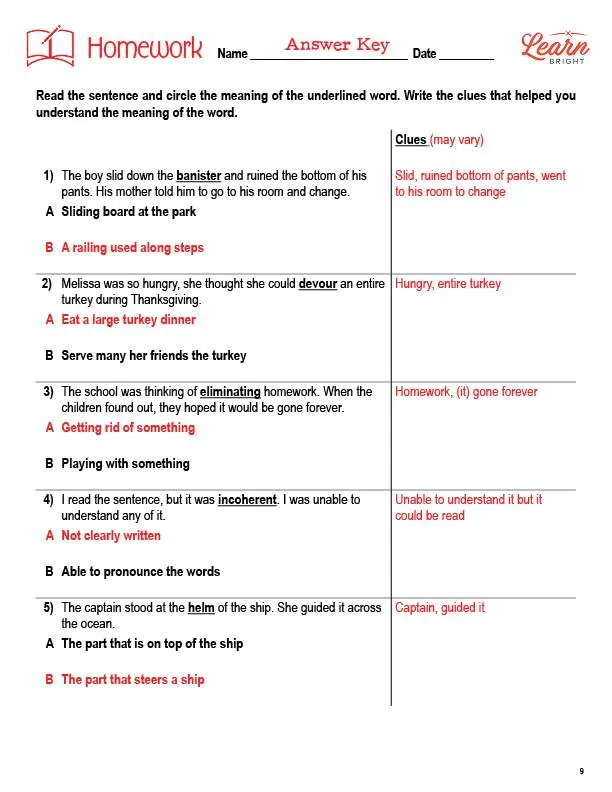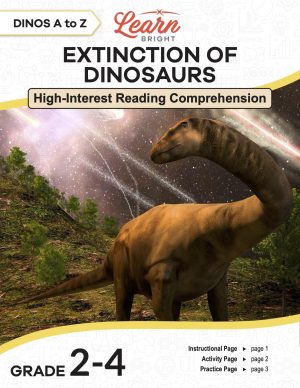Description
What our Use of Context for Self-Correction lesson plan includes
Lesson Objectives and Overview: Use of Context for Self-Correction teaches students strategies for using context clues to determine the meaning of words. At the end of the lesson, students will be able to use context to confirm or self-correct word recognition and understanding. This lesson is for students in 2nd grade.
Classroom Procedure
Every lesson plan provides you with a classroom procedure page that outlines a step-by-step guide to follow. You do not have to follow the guide exactly. The guide helps you organize the lesson and details when to hand out worksheets. It also lists information in the yellow box that you might find useful. You will find the lesson objectives, state standards, and number of class sessions the lesson should take to complete in this area. In addition, it describes the supplies you will need as well as what and how you need to prepare beforehand. To prepare for this lesson ahead of time, you can pair students for the activity and copy the handouts.
Options for Lesson
Included with this lesson is an “Options for Lesson” section that lists a number of suggestions for activities to add to the lesson or substitutions for the ones already in the lesson. One optional adjustment to the lesson activity is to either add more made-up words or have students create their own made-up words to use. An optional addition to the lesson is to have students randomly choose words from a dictionary and use them correctly in a sentence, including context clues. They can also find words they do not know in their current reading content, identifying clues that helped them determine the meaning of the words. Finally, you can hold a class “Context Bee,” where you use a new word in a sentence with context clues and students use those clues to guess the meaning of the word.
Teacher Notes
The teacher notes page includes a paragraph with additional guidelines and things to think about as you begin to plan your lesson. This page also includes lines that you can use to add your own notes as you’re preparing for this lesson.
USE OF CONTEXT FOR SELF-CORRECTION LESSON PLAN CONTENT PAGES
Context
The Use of Context for Self-Correction lesson plan includes two pages of content. The lesson begins by explaining that, even if students don’t know the actual definition of the word context, they likely understand how to use it. If you show your parents a report card with perfect grades, they might say that your grades are stupendous. In this example, you might not know what the word stupendous means, but you can infer that it means good or excellent. You determined the meaning of that word using the context of the situation.
You can use context to figure out the meaning of unfamiliar words in text from books or things that people say to you. Using context can help you determine the meaning of a new word, or give you a more accurate meaning for a familiar word. You might need to reread a paragraph or passage multiple times to help you determine the meaning of something. This will allow you to identify and decode the context clues.
Using Context
Using context to find the correct meaning of words or phrases takes practice. You can use context clues around the word to figure out the meaning. The lesson gives students a chance to practice these skills by including three examples with made-up words. Each example sentence gives enough context for students to figure out the meaning of the made-up words. The lesson also includes an explanation of what clues they can specifically use to figure out the meaning for each example.
USE OF CONTEXT FOR SELF-CORRECTION LESSON PLAN WORKSHEETS
The Use of Context for Self-Correction lesson plan includes three worksheets: an activity worksheet, a practice worksheet, and a homework assignment. You can refer to the guide on the classroom procedure page to determine when to hand out each worksheet.
MADE-UP WORDS ACTIVITY WORKSHEET
Students will work with a partner to complete the lesson activity. Each pair will create a sentence using each of five made-up words. They will determine the meaning of each word by including context clues in their sentences.
Students can also work either alone or in groups.
FIND THE CORRECT MEANING PRACTICE WORKSHEET
The practice worksheet asks students to use context clues to find the meaning of the underlined words in ten sentences. They will circle the correct answer from four options.
USE OF CONTEXT FOR SELF-CORRECTION HOMEWORK ASSIGNMENT
For the homework assignment, students will read five sentences and circle the meaning of each underlined word. They will also write the clues that helped them understand the meaning of the word.
Worksheet Answer Keys
This lesson plan includes answer keys for the practice worksheet and the homework assignment. If you choose to administer the lesson pages to your students via PDF, you will need to save a new file that omits these pages. Otherwise, you can simply print out the applicable pages and keep these as reference for yourself when grading assignments.









